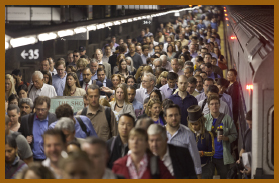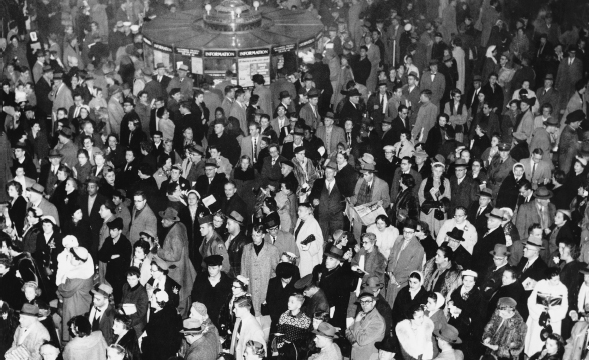

IF ROMANTIC LONG-DISTANCE TRAINS defined the terminal in the first half of its 100 years, commuters have done so in the second half. Commuter trains never developed the cachet that their long-distance cousins acquired, but carrying passengers to and from New York’s suburbs—giving the city its “tidal restlessness,” E.B. White wrote—was becoming a larger share of Grand Central’s traffic. (White himself bought his first copy of the New Yorker in the terminal in 1925 and later recalled, “I practically lived in Grand Central at one period—it has all the conveniences and I had no other place to stay.”) In 1906, while the terminal was still being built, 10 million commuters rode the New York Central and the New Haven lines. By 1930, their ranks had more than tripled, to 36 million of the 47 million or so total passengers whom Grand Central Terminal accommodated that year.
For well over a century, suburban commuters have been caricatured and uncharitably denigrated as elitist tree-huggers rendered zombie-like by their daily ritual. The New York of the commuter, White acidly wrote, “is devoured by locusts each day and spat out each night,” adding unapologetically, “The suburb he inhabits had no essential vitality of its own and is a mere roost where he comes at day’s end to go to sleep. Except in rare cases, the man who lives in Mamaroneck or Little Neck or Teaneck, and works in New York, discovers nothing much about the city except the time of arrival and departure of trains and buses, and the path to a quick lunch… The commuter dies with tremendous mileage to his credit, but he is no rover.”
Few profiles were as eviscerating as Gail Sheehy’s in New York magazine in 1968, when New Yorkers were beginning to feel a little defensive about their town and wondering whether, in the middle of a transit strike two years earlier, the columnist Dick Schaap was engaging in bitter irony when, paraphrasing Mayor John V. Lindsay, he dubbed New York “Fun City.” Sheehy’s profile began: “They never stop moving. They come into Grand Central every morning off the 86-seat sit-up hearses. And every night the blank faces look out of Charlie Brown’s bar at the Pan Am escalators and wait to go home at the same time on the same train in the same car with the same ‘congenial group.’ ”
The daily tide of commuters might seem anonymous—even to their fellow passengers—but they fell into categories that Sheehy acerbically described. They included the congenial Mad Men going home to wives and families. “Avid agency and fashion geishas know they can learn from these men,” she wrote. “Pick up the Avenue style, pick up a telephone recommendation from a bar car titillation. They are known as Belles of the Bar Car.” The regulars included a less congenial character, she explained: “No one wants to become a Tunnel Inspector, a man who sits alone, speaks to no one and—when the morning train goes under at Park and 96th—races through to stand between the couplings of the two head cars.” Regardless of which category the commuter belonged to, each shared the same fate, according to Sheehy: “There is one inexorable inevitability about his life: At both ends of his day, like margins, is another train to catch.”

NOW WHAT? PERPLEXED COMMUTERS CONVERGE ON THE INFORMATION BOOTH DURING A NEW YORK SUBWAY AND BUS WORKERS’ STRIKE.
JOHN CHEEVER’S FICTIONAL SHADY HILL was populated by desperate commuters, and Gregory Peck’s Man in the Gray Flannel Suit was one. But changing demography has challenged the stereotypes (nearly half the commuters today are women). And even when generalizations were more valid, each commuter had an individual story to tell, and the mass of commuters, like the earlier waves of long-distance passengers, came to Grand Central, at least when they first arrived, with dreams. Jim Link, an accountant from Greenwich, his grandfather, a psychiatrist, and his father, an artist, commuted in tandem from the suburbs for a century. “For over 100 years,” he said in 2002, “one of us has been walking through Grand Central.” Another commuter, Herbert Askwith of Larchmont, was responsible for single-handedly nudging the railroad to set its clocks and timetables to daylight time.
Commuting can foster a real camaraderie as fellow passengers celebrate passages into other life stages—people have been born and married in Grand Central and others have died there—or just enjoy a poker game or holiday cheer. By the middle of the 1930s, the impact of the Depression was beginning to fade, at least for well-heeled commuters from New Canaan, Connecticut. They petitioned the New York, New Haven & Hartford Railroad to restore the club car on the 5:12 from Grand Central with its white-coated attendant. “We’re not rich men,” said George H. Yuengling, an insurance broker. “We’re all hard working fellows who like relaxation and are willing to pay a little extra to avoid the discomforts of ordinary commuting.”
Bill Geist, the CBS television commentator, once recalled the Christmas party on Car No. 8657 on the New Haven’s 5:20 from Grand Central to Westport. Regulars decorated the car and hired a six-piece band. Habitués of bar cars are no different from colleagues stopping at a saloon on the way home, except they are more likely to be excused for wobbling between stations.
A whole genre—stragglers who miss the last train before the terminal closes at 2 a.m.—has developed a culture of stranded “train wrecks,” some of whom wash away their tears in a local bar or offer themselves up as “Cinderella fares” to lucky cabbies. (In cold weather, one door on 42nd Street is staffed by a police officer who lets stragglers and the homeless into a makeshift lobby.) In 1932, Norman L. Holmes of Danbury was so determined not to miss his train home that he stole an ambulance from St. Vincent’s Hospital and drove it to Grand Central with its siren wailing (he crashed into a parked car on 44th Street and was arrested).
Other commuters managed happier endings. One man, a 65-year-old lawyer from Queens who had no choice but to stand on a crowded train from Grand Central to White Plains, won a jury verdict against the New York Central of $11.80—a refund of his $1.80 fare plus $10 in damages for “discomfort.” That was in 1947, and his victory before a civil court judge was his second against the railroad. A decade earlier, he sued the New York Central because he was forced to stand on a train to Albany and won a precedent-setting verdict (a $2.80 refund and $45 for discomfort) that established the principle that passengers who purchased tickets for long-distance trains had to be guaranteed a seat.
Walter S. Titlar, an insurance man who had been commuting from Ossining to Manhattan for three months short of a half century, reaped his own reward after piling up 750,000 miles on the Hudson line. (When he started as a messenger for Metropolitan Life, his $7.20 monthly commutation fare was higher than his $5 weekly salary. When he retired at 65, he was making $300 a week and paying $30.95 for his monthly commute.) In 1961, Titlar donned a visored cap and fulfilled a 50-year boyhood dream, riding beside the engineer in the locomotive of the 5:22 from Grand Central.